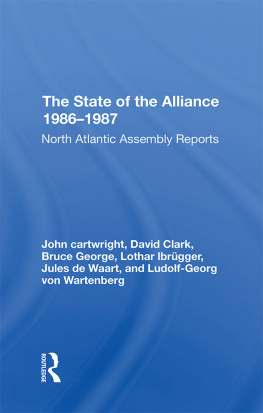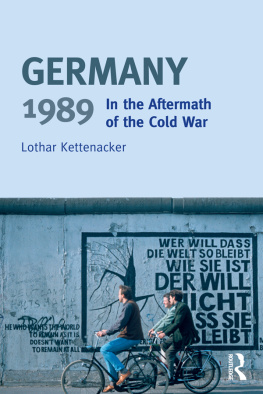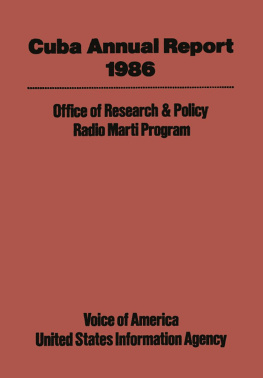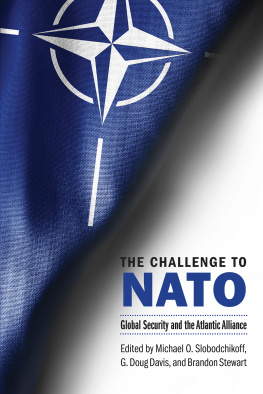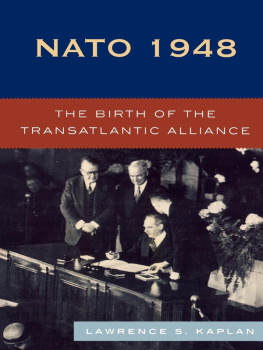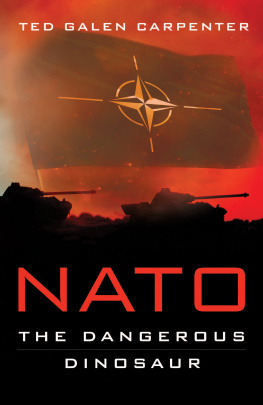The State of the Alliance 1986-1987
About the North Atlantic Assembly
Founded in 1955, the NORTH ATLANTIC ASSEMBLY is the interparliamentary organization of the Atlantic Alliance. Composed of 186 legislators from the 16 member nations of the Alliance, the Assembly provides a unique forum where politicians can meet and discuss issues of common concern. In this way the Assembly has continually promoted the principle of transatlantic understanding within the framework of a free, democratic Alliance.
As the NATO Heads of State mentioned in Article 13 of the 1974 "Declaration on Atlantic Relations," one of the primary means by which Alliance cohesion can be furthered is by encouraging the free exchange of views among the elected representatives of the peoples of the Alliance. Within this context the Assembly's task is to:
- strengthen the contacts between the national parliaments to promote Alliance cohesion;
- serve as an important source of accurate information on Alliance issues for legislators;
- encourage a mutually beneficial information exchange between NATO leaders and legislators;
- provide a communication link between NATO, Alliance parliaments, and the general and specialized public.
The majority of Assembly activities are carried out within the framework of six committees dealing with civilian, economic, military, political, scientific and technical affairs, and nuclear strategy and arms control. The committees meet twice annually, during the spring and autumn sessions, to discuss and vote on draft reports and policy recommendations. The policy recommendations are subsequently submitted to the Assembly's plenary. If approved, they are then passed on to the NATO Secretary General, who in consultation with the NATO Council formulates a reply.
Under the auspices of the committees there are seven subcommittees that conduct fact-finding missions to gather information for the draft reports. The subcommittees are: The Free Flow of Information and People, Public Information, Conventional Defence, Defence Co-operation, Eastern Europe, Terrorism, and Advanced Technology and Technology Transfer.
About the Book and Authors
Leaders of NATO countries are continually faced with the need for highly accurate information on complex issues such as arms control, nuclear strategy, electronic warfare, ABM compliance, SDI, terrorism, economic cooperation, East-West relations, and diverging public opinion. To provide ongoing analysis of these issues, the North Atlantic Assembly conducts extensive research, fact-finding missions, and interviews with high-level government experts. Committees then analyze the data and meet annually to present the results. The studies in this volume, which were presented to the 1986 annual session of NATO legislators, focus on the state of the Alliance. This collection provides a comprehensive evaluation of political developments within the Alliance, probes fundamental controversies underlying Alliance security, and sheds light on the aggregate of concerns surrounding the direction of arms control negotiations and the state of NATO's nuclear strategy. The book includes an appendix containing the policy recommendations that the Assembly has adopted and forwarded to the secretary general of NATO and heads of Alliance governments.
John Cartwright is a member of the Social Democratic Party of the United Kingdom; Dr. David Clark , the British Labour Party; Bruce George , the British Labour Party; Lothar Ibrgger , Federal Republic of Germany, the Social Democratic Party; Dr. Jules de Waart , the Dutch Labour Party; and Dr. Ludolf-Georg von Wartenberg , the Christian Democratic Party.
Published in cooperation with the North Atlantic Assembly
The State of the Alliance 19861987
North Atlantic Assembly Reports
John Cartwright, David Clark, Bruce George, Lothar Ibrgger, Jules de Waart, and Ludolf-Georg von Wartenberg
First published 1987 by Westview Press, Inc.
Published 2019 by Routledge
52 Vanderbilt Avenue, New York, NY 10017
2 Park Square, Milton Park, Abingdon, Oxon OX14 4RN
Routledge is an imprint of the Taylor & Francis Group, an informa business
Copyright 1987 Taylor & Francis
All rights reserved. No part of this book may be reprinted or reproduced or utilised in any form or by any electronic, mechanical, or other means, now known or hereafter invented, including photocopying and recording, or in any information storage or retrieval system, without permission in writing from the publishers.
Notice:
Product or corporate names may be trademarks or registered trademarks, and are used only for identification and explanation without intent to infringe.
Library of Congress Catalog Card Number: 86-51673
ISBN 13: 978-0-367-29632-2 (hbk)
Contents
Ton Fririking
Peter Corterier
David Clark
Ludolf-Georg von Wartenberg
Jules de Waart
Bruce George
Lothar Ibrgger
John Cartwright
Since its founding in 1955 as an informal group of Alliance politicians, the North Atlantic Assembly has become an influential body composed of 186 legislators meeting biannually to debate Alliance issues. The Assembly's rapid development over the past thirty-two years is a testament to the serious commitment of its members to promoting a common feeling of Alliance cohesion among the sixteen legislative Assemblies which have ratified the North Atlantic Treaty.
The vitality of the Assembly is also evidence that the widely stated axiom of the 1950s, that Alliance political unity at the governmental level would remain precarious and perhaps illusory unless underpinned by unity at the level of popular representative institutions, is as relevant today as it was then.
The Assembly supports Alliance unity in a unique manner by providing a forum where Alliance legislators representing every political persuasion can constructively work on consensus building.
When former Secretary of State John Foster Dulles prophesied in 1954 that "an advisory Atlantic Assembly representing the NATO area as a whole would have genuine value particularly as a means of fostering better public understanding of the common problems of the Atlantic nations and of focusing the outstanding skills and talents of parliamentarians upon these problems" one may have wondered to what future such an organization could aspire.
Over the years, however, any lingering doubts about the value of the Assembly as a contributor to Alliance solidarity have vanished. The Assembly today is, in the words of President Reagan, "the only interparliamentary consultative body in which elected representatives of the United States, Canada, and their Western European allies meet regularly to address issues of world peace, collective deterrence and defense, and international co-operation".
Throughout its history the Alliance has always had to surmount the myriad of challenges that inevitably arise in an Alliance of democracies. The member governments are now faced with an extensive list of urgent challenges that include arms control, terrorism, economic, technological and defence co-operation, and waning public support for the Alliance on both sides of the Atlantic. The North Atlantic Assembly is playing an important role in helping NATO members meet these challenges through its research, debates, and concrete policy recommendations which are passed on to Alliance officials at the highest level. In this way the Assembly is working to maintain a healthy, viable and unified Alliance capable of defending the free democratic institutions we all cherish so dearly.


